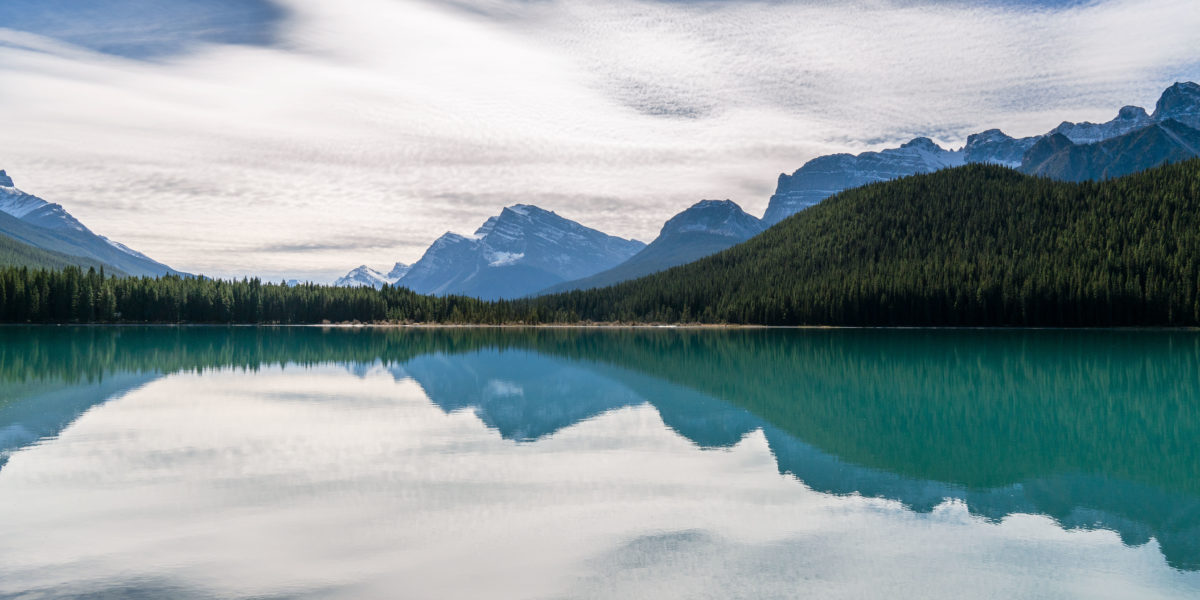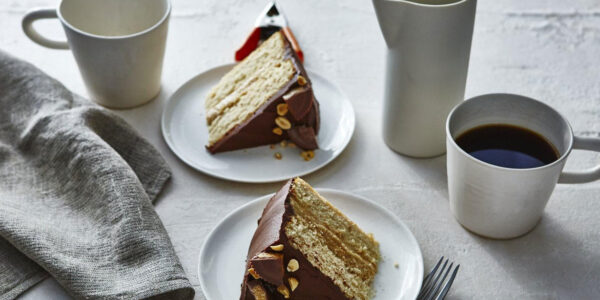
Awe-Inspiring Canadian Rockies Camping Adventure
In Canada’s alpine national parks, a crisp late-season road trip offers one last chance to camp the northern range before winter settles in

Twenty minutes into the trail, I come face-to-face with a slab of ice older than human civilization. The pockmarked mass climbs high up the barren mountain valley–a blinding crux of snow, cloud, and sky. And for a moment, the kind that always draws me to wild places, I can’t tell the difference between earth and heaven.
Signs tell me that a century ago the Athabasca Glacier in Alberta, Canada, sat at the edge of the nearby road and since then has receded nearly a mile to where I am now. At this rate, it may be just another hundred or so years before there is no Athabasca at all. Standing next to me alongside pools of meltwater frosted over in the morning shade, a baby swathed in a red snowsuit is harnessed to his American father’s chest, staring at it all. “This is the coldest he’s ever been,” says the dad.
And it’s true. The weather report calls for far-below-freezing temps–even though it’s only September 21. After all, we are on an ice field. By comparison, in Denver or Santa Fe, the air can often be downright balmy on this, the first day of autumn. But up in the Canadian Rockies, it means winter is already setting its sights on the high peaks, the very ones that had been calling to me from my home more than 2,000 miles east in concrete Toronto. I had been crawling through snarled city traffic to spend my days writing at a TV news station, and the recent political fatigue that gripped my American friends had crossed the border. In other words, I was drained. It was time to put my computer away, go somewhere wild, and be awed.
So I booked a flight to Calgary and rented a little SUV, figuring I’d spend a few days exploring three Canadian national parks–Banff, Jasper, and Yoho–that straddle the mountainous boundary between Alberta and British Columbia. I expected forests painted with sunbursts and campsites defined by late-season emptiness. No headlines. No crowds. Just gobsmacking nature and perhaps some fellow intrepid campers along the way.
Base Camp Banff
Things start out solitary and picturesque enough. Less than an hour out of Calgary, I follow a highway along the broad Bow River. The mountains huddle closer and closer to the road, and I get my fall color in splashes of yellow larches that pop against green carpets of pine.
An hour and change later, I pitch my tent at Banff National Park’s sprawling Two Jack Lakeside Campground amid a cathedral of conifers. (It’s usually open through the end of September, weather permitting.) Though I’m only 79 miles away from Calgary, I feel like I’ve succeeded at getting admirably close to the middle of nowhere. But before I can trace the pebbly shore of Lake Minnewanka, my neighbor’s gargantuan Bernedoodle puppy, Vesper, comes over to lick my hand.
“It’s lovely this time of year,” says Sebastian, the dog’s owner, while looking out at the near-empty campground with his partner, Brittany. In no time I’m touring their delightfully retro camping trailer, with its silver Ziggy Stardust lightning bolt bisecting the yellow and white paneling. Inside the 1980s trailer, it’s all bright pine and snug blankets.
She’s an art historian, and he’s an artist and composer; they met in Montreal and moved to Banff two years ago. They’ve been soaking in the campground’s low-season serenity for the past week, leaving their trailer here when they commute into town for work. But today, a Sunday, they’re keeping warm by a fire with steaming mugs of tea. “It’s like a retreat,” Brittany says. “You can have a cosmopolitan life in Banff and sleep out here at night.”
The encounter puts me in a more social mood than I expected. Rather than curl up with a lantern and a novel, I decide to cruise into town later that evening. In summer, Banff’s legendary tourist traffic and plaid Canadiana kitsch can easily take your focus off the roiling Bow River and the surrounding snowy mountains. But after September, as visitors dwindle, a calm descends.
I pass downtown’s old brick facades and newer chalet-style buildings before taking an empty gondola up Sulpher Mountain for a sunset summit stroll. As the light fades, the ambient temperature flirts with freezing. So I head back down to where the steaming waters of Banff Upper Hot Springs wait just beyond the gondola parking lot. What better time for a dip?
A young woman soaks in the large outdoor pool with her beau. Through my fogged-up eyeglasses I catch her grinning at me. “Sorry,” she says. “It’s just … your bathing suit.” I’m sporting a navy “historic” one-piece with a white stripe around my waist.
“It’s a rental,” I explain. “I forgot my trunks.” “Yeah?” the guy laughs. “We rented the normal ones.” I look around, recalling that this natural wonder actually helped spark the development of the town itself in the 1880s. There are couples and families and conversations in many languages. Era-specific bathing suits? Zilch. Everyone else looks thoroughly modern.
Warmed to the core, I head back to the campground to huddle in my down sleeping bag, my breath steaming against the cold. When I emerge in the morning, the campground is dusted white. I boil water for coffee and fry an egg, snowflakes melting against my small gas camping stove.
“I could have used Vesper last night,” I tell Sebastian, who’s sitting by a fire. At the mention of his name, the dog leaps up, his paws near my shoulders.
“That’s just the Rockies in the fall,” Sebastian says. “It’ll be sunny one day and snowing the next.”
Land of Elk and Ice
After I pack up and drive north, the snow begins to wane. I turn off onto a narrow road that climbs to Moraine Lake, a stunning stretch of turquoise water surrounded by jagged summits. The serrated slopes appear to crumble all the way down to the waterline.
The plan is to make the 5.3-mile round-trip trek to Larch Valley, which Brittany and Sebastian had vowed was the park’s most magnificent autumn hike. But now, as I actually head out on the trail, I’m thinking back to my stop at the park’s visitor center in town. I was there to pick up a map, when one of the rangers asked if I was planning on hiking alone. I said I was. “Bring bear spray,” she urged. “They’re out and feeding. Winter is coming.”
So I thumb the canister holstered to my hip as the trail ascends forested switchbacks, then levels out in a valley where groves of larch trees–shaped like evergreens, but deciduous–stand aflame with golden needles under foreboding crests and sparkling blue glaciers. It’s like a spectacular forest of fiery Christmas trees.
The hike eats up a fair amount of my day, and it’s nearly dark when I drive through the Sunwapta Pass, which marks the boundary between Banff and Jasper National Parks. I’m now at nearly 6,700 feet of elevation, and the temperature on my dash hovers at a sobering 30 degrees (Fahrenheit, in case you were wondering). I decide another campground stay would be uncomfortable and rather foolish. Instead, I find a room at the Glacier View Inn. Perched in a world of windswept rock and ice, with little else around, the Spartan hotel feels like a lunar base merged with a Swiss chalet.
Through my window, the Athabasca Glacier gleams in the moonlight. It’s just one of eight glaciers that feed the 125-square-mile Columbia Icefield, the largest expanse of ice in the Rocky Mountains.
The next morning, I visit the leading edge of the ice sheet, where I meet the freezing American and his snowsuit-clad progeny. But soon I’m on my way–the chill in the air above the treeline brings an added sense of urgency, as if warning me not to outstay my welcome.

Highway 93 North, also known as the Icefields Parkway, descends in elevation between Sunwapta Falls and Jasper, following the Athabasca River as its azure waters cut boulder-strewn bands through montane forest. By the time I roll into the town of Jasper–with its leafy clapboard neighborhoods, legion hall bar, and smattering of shops and restaurants alongside a historic railroad–the temperature climbs to a welcome 60 degrees.
The car window is still down when I arrive at Jasper National Park’s Whistlers Campground. But I build a crackling campfire as soon as I park–just in case. Nearby, a family speaks in what sounds like German. Another, Korean, enjoys a barbecued feast on mats. I chat for a second with my neighbor, a middle-aged Portlandian who’s wearing a bright orange puffer jacket, before he dashes off to wash his dishes.
Too soon, he comes rushing back and begs me to follow him toward the restroom. There’s a cry and a clatter before I finally see them: two bull elk in combat, resplendent with their gnarled crowns and thick coats. They stop, huff, and briefly graze. Then they’re back, their horns cracking together for a small audience of gawking campers. I keep my distance. Finally the elk calm down, and everyone wanders back to their simple campsites.
My digs, on the other hand, are pretty cushy: I’ve reserved one of the campground’s Otentik framed canvas tents equipped with a bench and table, electric light, and a wall of bunks that can sleep a whole family. I crawl into the bottom bunk, thrilled to be warm and toasty from the neck down with just the right amount of chill in the air to lull me to sleep while the tent’s electric heater gently hums all night long.
Mountain Retreat
The next morning I drive back toward Calgary. But instead of heading straight to the airport, I turn west when I reach the Trans-Canada Highway just north of Lake Louise and cross the border into British Columbia and its less famous Yoho National Park. Established one year after Banff in 1886, Yoho is considerably smaller, with about 500 square miles of grand lakes, thunderous falls, and mountain heights. I park at a day-use area near the plunging ribbon of 833-foot-high Takakkaw Falls, grab a rucksack weighed down with food and supplies, and set out for the 78-year-old Stanley Mitchell Hut. The Alpine Club of Canada manages an entire network of these communal, hike-in cabins tucked deep in the Rockies, pairing pure isolation with relative ease of access.

I follow a trail along a gushing river, past an ice-fringed waterfall, and then up over a forested ridge, panting under my load. It’s hot in the sun, yet in the densest parts of the forest, the earth crunches with a layer of frost.
Six miles and more than three hours later, I emerge in a meadow ringed by peaks, where a big wood cabin sits just below the treeline, smoke wafting from its chimney. Inside, a woodstove glows in the dim light, and a couple lounges on benches, absorbed in their books as the late afternoon light slants through the windows.
They both look up. For a moment, I almost feel like I’ve intruded. Gruff but ultimately affable, with gray curls and an unkempt goatee, Erwin has the build and demeanor of a retired football player. With a tidy bob and easy smile, Okju is his polar counterpart. Retired and nearing 60, they tell me they divide their time between homes in Erwin’s native Mexico and nearby Idaho. Since being turned on to these alpine huts by a Canadian friend a few years back, they’ve fallen in love with them.
“You can’t get away from the cold in a tent,” Okju says. “And we’re not in our 20s anymore.”
“Some of the places down in the States, you have to walk for a week to see the same stuff you see here,” Erwin adds.
“Like yesterday,” Okju explains. “We went up to the pass and you look around, 360 degrees, and there is nobody else–it’s just you and nature.”
For the past week, they’ve hiked nearby trails and spent their nights in this cozy living room with visitors from around the globe, free of phone service and Wi-Fi. Tonight, we share the hut with a young couple from Banff. Erwin and Okju naturally assume a parental air, tending the woodstove and propane lights and keeping an eye on the glacial water boiling in the kitchen while we drink what we’ve hauled in (spiced rum in a water bottle for me; cans of beer for the Banff couple; wine for Erwin and Okju).
After they wax poetic about their decades together on the road, I explain my goal for being out here; about seeking respite from work and urban woes through wilderness and isolation. Erwin looks into his mug of wine.
“It’s fine to be by yourself,” he says. “But it’s also nice to see other people. If you come out here and spend the night, you will have similar interests. Different backgrounds, but similar interests.”
I find a space in the attic’s big communal bunk. By the time I wake up the next morning, the couple from Banff is gone. Erwin leads me to a stream to refill the cabin’s buckets with clear, frigid water. He then takes me around back for an impromptu lesson in splitting wood. Effortlessly, he cleaves a log with one graceful swoop. I mirror his broad-legged stance, take aim, and split one too.
“Not too bad for a city boy,” I say, before swinging at another and missing entirely, the ax’s blade cutting into the earth by my foot.
He laughs, and reminds me of the central principle of ax wielding: Don’t chop off your toes. After all, I’ll need them if I’m ever going to make it back to Calgary.
Three Ways to Camp the Rockies

Tent Camping: You’ll find 30-plus campgrounds scattered throughout the Canadian Rockies’ three adjacent national parks, Yoho, Jasper, and Banff. They range from easily accessible sites with showers, firepits, and restrooms to bare-bones hike-in locations with room for just a few dozen tents. Interested in backcountry camping? Reserve a permit through the Parks Canada system, which began serving Jasper two years ago and launched for Yoho and Banff National Parks this past March. Whenever and wherever you go, bring layers and a warm sleeping bag–even at the height of summer, it can get mighty cold up here. From $7.45 U.S./night; parkscanada.gc.ca.

Glamping: If you don’t want to lug a ton of gear around, consider an Otentik. A recent addition to Canada’s national parks, these large, wood-framed canvas tents are outfitted with bunks that can sleep six, a small kitchen area, tables and chairs, an electric heater, plus picnic tables and firepits outside. You’ll find them at Jasper National Park’s Whistlers Campground, where you have an excellent chance of spotting wild elk in the fall, and also at Banff National Park’s Tunnel Mountain Village II Campground and Two Jack Lakeside Campground. From $91 U.S./night, reservations recommended; parkscanada.gc.ca.

Hike-in Huts: The Alpine Club of Canada operates nearly 30 communal backcountry huts that have been sheltering hikers and climbers for generations. While many require mountaineering experience to access, some–like the Stanley Mitchell Hut in Yoho National Park–simply entail a long, though relatively flat, hike. All sport fully equipped kitchens, propane lighting, woodstoves, and freshwater collection systems, and can sleep a handful of people in dorm-style rooms. From $30 U.S./night; alpineclubofcanada.ca.
